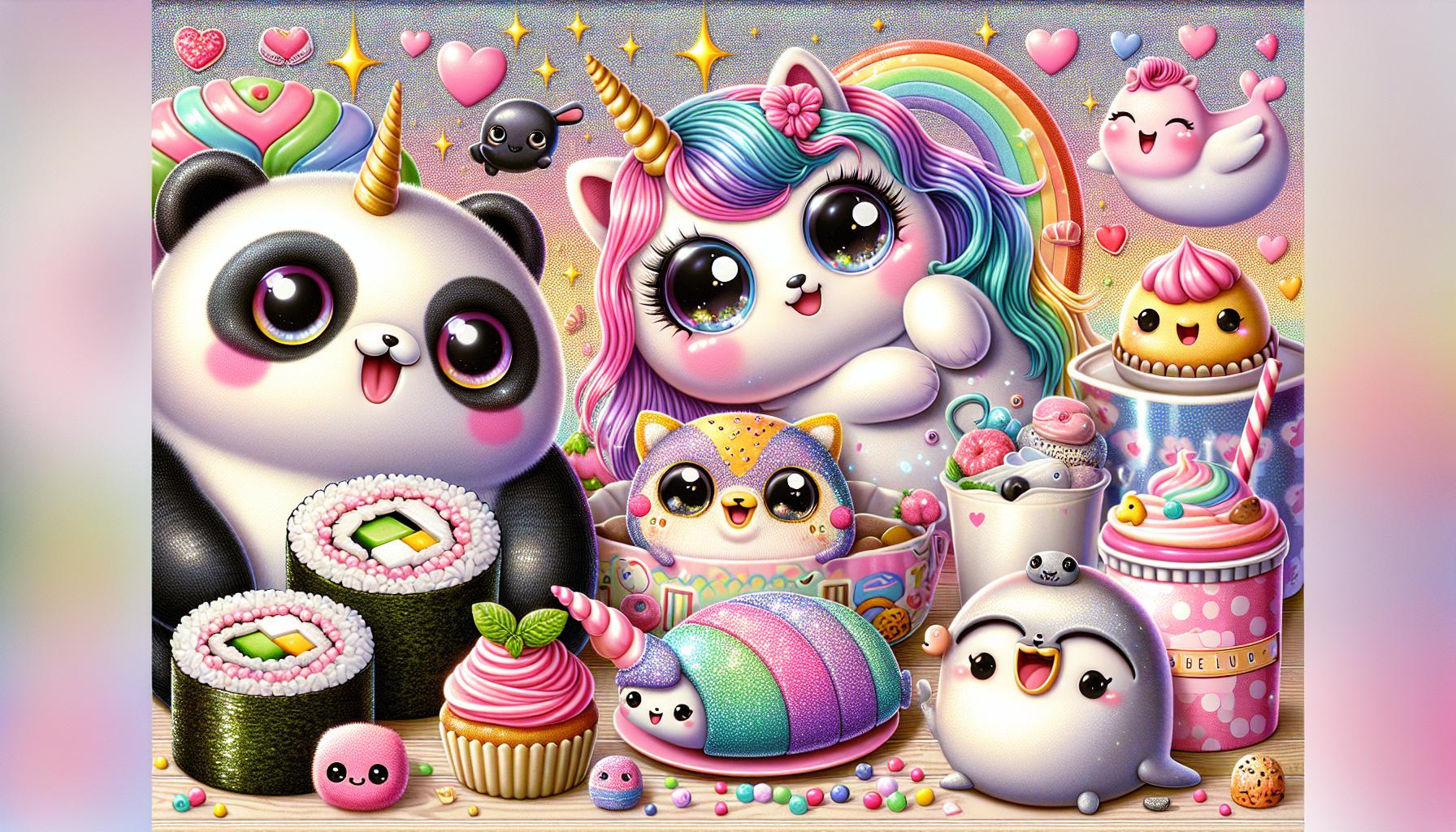The enchanting world of kawaii drawings has captured hearts worldwide with its irresistibly cute characters and simple artistic style. From adorable animals to charming everyday objects these delightful doodles bring joy to both aspiring artists and art enthusiasts alike.
Learning to create kawaii art doesn’t require years of artistic training or complex techniques. With just a few basic shapes and some creative flair anyone can master the art of drawing these lovable characters. Whether you’re a complete beginner or looking to expand your artistic repertoire kawaii drawings offer a fun and accessible way to express creativity and bring smiles to faces everywhere.
Facil:ekagqaf3ivu= Kawaii:zj7frljcr3s= Dibujos
Kawaii drawings represent a distinctive Japanese art style characterized by simplified forms with exaggerated cute features. The term “kawaii” translates to “cute” or “adorable” in Japanese, encompassing artwork that emphasizes large eyes, rounded shapes, soft colors.
Key characteristics of kawaii drawings include:
- Oversized heads with small bodies creating a baby-like proportion
- Large expressive eyes taking up significant facial space
- Minimal facial details focusing on essential cute elements
- Soft pastel color palettes incorporating pink, blue, yellow
- Simple geometric shapes forming the base structure
Common subjects in kawaii art encompass:
- Animals rendered in chibi style like kittens pandas bunnies
- Food items with happy expressions such as sushi cupcakes
- Everyday objects transformed into cute characters
- Fantasy creatures including unicorns dragons fairies
- People depicted with childlike features anime style
Here’s a breakdown of typical kawaii drawing elements:
| Feature | Description | Purpose |
|---|---|---|
| Eyes | Large circular shapes | Creates emotional appeal |
| Face | Small nose tiny mouth | Maintains simplicity |
| Body | 1:2 or 1:3 head-body ratio | Enhances cuteness factor |
| Colors | Soft pastels light shades | Adds gentle appeal |
| Details | Minimal blush marks sparkles | Emphasizes charm |
The kawaii style originated in 1970s Japan through manga comics teenage fashion. Modern kawaii drawings appear across digital art platforms social media stationery products entertainment media.
Essential Materials for Creating Kawaii Art

Creating kawaii art requires specific tools that enhance the cute aesthetic characteristics. The right materials enable artists to achieve the signature kawaii look with smooth lines, soft colors, and delicate details.
Basic Drawing Supplies
Traditional kawaii art starts with quality drawing paper (70-90 lb weight) for clean lines and erasure resistance. Fine-liner pens (0.1-0.5mm) create precise outlines, while colored markers (Copic, Prismacolor, Tombow) add vibrant hues to kawaii characters. Essential items include:
- HB pencils for initial sketching
- White eraser for clean corrections
- Circular templates for perfect circles
- Brush pens for varied line weights
- Pastel markers for soft color fills
- White gel pens for highlights
- Blending tools for smooth transitions
Digital Drawing Tools
Digital kawaii art creation centers on drawing tablets paired with specialized software. Professional artists use these core digital tools:
- Drawing tablets (Wacom, XP-Pen, Huion)
- Art software (Procreate, Clip Studio Paint, Adobe Photoshop)
- Digital brushes optimized for lineart
- Color palettes with pastel presets
- Stabilization tools for smooth lines
- Layer management systems
- Custom kawaii-style brushes
- Cloud storage for artwork backup
| Feature | Purpose |
|---|---|
| Pressure sensitivity | Line weight control |
| Canvas sizes | 2000x2000px minimum |
| Resolution | 300 DPI for print |
| Layer capacity | 100+ layers |
Simple Kawaii Drawing Techniques

Kawaii drawings start with mastering fundamental techniques that emphasize simplicity and cuteness. These methods focus on creating adorable characters using basic geometric shapes combined with expressive features.
Basic Shapes and Forms
Kawaii art begins with circles squares triangles as foundational elements. Artists combine these shapes to create character bases: circles for heads ovals for bodies smaller circles for ears. The proportion ratio maintains a 1:2 head-to-body relationship creating that distinctive chibi look. Essential geometric combinations include:
- Circle pairs for rounded ears paws
- Triangles for animal features whiskers tails
- Ovals for limbs accessories decorations
- Heart shapes for noses cheeks embellishments
- Large round eyes with reflection dots
- Small curved lines for eyelashes
- Tiny U-shaped mouths centered below eyes
- Rosy circle cheeks placed at mouth level
- Minimal nose details using dots dashes
- Curved eyebrows for enhanced expressions
- Small highlight marks near eyes
Popular Kawaii Characters to Draw

Kawaii characters encompass a diverse range of subjects that capture hearts with their adorable features and expressive personalities. These characters serve as perfect starting points for artists exploring the kawaii style.
Animals and Creatures
Animal-based kawaii characters feature rounded shapes and exaggerated cute elements that make them instantly recognizable. Popular choices include cats with oversized heads and sparkly eyes, chubby pandas with tiny ears, fluffy bunnies with button noses. Mythical creatures like unicorns incorporate pastel manes and star-shaped accessories. Sea creatures transform into adorable forms with baby seals sporting rosy cheeks, whales with heart-shaped blowholes, and octopi with tiny crown accessories. Forest animals gain kawaii charm through deer with flower crowns, foxes with bow ties, and bears with honey pot accessories. The key elements focus on emphasized eyes, simplified facial features, and signature accessories that define each character’s personality.
Food and Objects
Kawaii food characters bring everyday items to life through playful expressions and charming details. Sushi rolls display winsome smiles, ice cream cones wear tiny bows, and cupcakes feature glittery sprinkle details. Common household items transform into lovable characters through creative personification: pencils with determined expressions, backpacks with sleepy faces, coffee cups with rosy cheeks. Kitchen items gain personality through teapots with heart-shaped steam clouds, rice bowls with starry eyes, and toast slices with jam-heart decorations. Electronics become endearing with smartphones wearing headphones, gaming consoles with pixel hearts, and laptops with rainbow keyboard patterns. Each character incorporates signature kawaii elements like blushing cheeks, tiny hands, and decorative accessories.
Tips for Developing Your Kawaii Style
- Master Basic Shapes
- Practice drawing circles in varying sizes for heads bodies
- Create rounded rectangles for limbs accessories
- Use triangles for ears animal features facial expressions
- Develop Consistent Line Work
- Draw light sketch lines first using mechanical pencils
- Apply smooth continuous strokes with fine tip markers
- Keep outlines clean uniform throughout the piece
- Perfect Eye Expressions
- Position large eyes at 1/3 mark of the face
- Add sparkles or highlights for liveliness
- Include curved eyebrows to convey emotions
- Enhance with Details
- Draw small blush circles on cheeks
- Add tiny accessories like bows hearts stars
- Include simple patterns on clothing or backgrounds
- Experiment with Color Palettes
- Choose soft pastel shades for main elements
- Use complementary colors for contrast
- Apply light gradients for dimension
- Focus on Proportions
- Maintain 1:2 head to body ratio
- Keep facial features balanced symmetrical
- Draw extremities smaller than central elements
- Create Character Variations
- Mix animal features with human expressions
- Transform everyday objects into cute characters
- Combine different kawaii elements for unique designs
- Practice Digital Techniques
- Use stabilizers for smooth curved lines
- Create custom kawaii brushes for efficiency
- Apply layer effects for depth texture
This structured approach emphasizes essential elements while building upon the previously established kawaii drawing fundamentals. Each technique reinforces the core characteristics of the kawaii style through specific actionable steps.
Best Practices for Beginners
Starting with simple shapes forms the foundation of kawaii drawings. Artists create basic circles for heads paired with smaller circles or ovals for bodies.
Essential principles for kawaii beginners include:
- Draw symmetrical features using guidelines
- Practice consistent line weights for outlines
- Add details gradually from basic shapes
- Keep designs minimal with 3-4 facial elements
- Use soft colors in limited palettes of 4-5 shades
Proper workspace setup enhances the drawing experience:
- Position paper at a 15-degree angle
- Maintain good lighting from the left side
- Keep reference images within eyesight
- Store materials in designated containers
- Clear the workspace of distractions
Time management strategies improve skill development:
- Practice 15-minute daily sketch sessions
- Focus on one feature type per session
- Review progress weekly
- Study reference art for 10 minutes daily
- Complete one full character every 2-3 days
Common mistakes to avoid:
- Overcrowding facial features
- Making asymmetrical eyes
- Using harsh black outlines
- Adding too many accessories
- Skipping basic shape practice
Learning resources support beginner growth:
- Step-by-step kawaii tutorials
- Online kawaii art communities
- Digital drawing templates
- Basic shape practice sheets
- Character reference libraries
| Activity | Frequency | Duration |
|---|---|---|
| Sketch Practice | Daily | 15 min |
| Feature Study | 3x Weekly | 20 min |
| Full Character | Bi-weekly | 45 min |
| Style Analysis | Weekly | 30 min |
| Technique Review | Monthly | 60 min |
The world of kawaii drawings offers endless possibilities for artistic expression through its charming and accessible style. Artists of all skill levels can embrace this creative outlet to bring joy both to themselves and others through adorable characters and whimsical designs.
Whether working traditionally or digitally anyone can master kawaii art by focusing on basic shapes applying simple techniques and developing their unique style. With dedication practice and the right tools artists can create heartwarming pieces that capture the essence of cuteness that defines the kawaii aesthetic.
The kawaii art movement continues to grow globally inspiring creators to spread happiness one adorable drawing at a time. It’s a testament to the universal appeal of cute art and its power to connect people across cultures through creativity.

